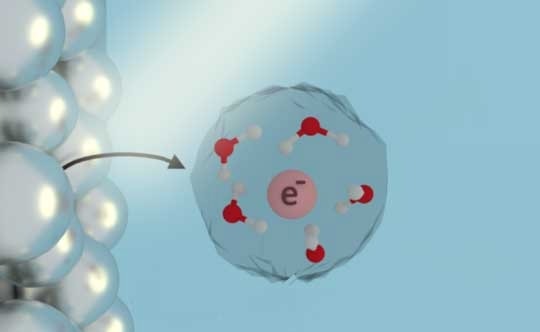Reviewed by Aimee MolineuxJan 19 2023
There are numerous ways to begin chemical reactions in liquids, but adding free electrons into water, ammonia, or other liquid solutions is particularly appealing for green chemistry. This is because solvated electrons are naturally clean and do not produce any byproducts when they react.
 When scientists shine low-intensity near-ultraviolet light on metal nanoparticles, electrons in the nanoparticles oscillate. This oscillation, referred to as a plasmon, can give the electrons enough energy to emit into the surrounding solution. Image Credit: Rice University
When scientists shine low-intensity near-ultraviolet light on metal nanoparticles, electrons in the nanoparticles oscillate. This oscillation, referred to as a plasmon, can give the electrons enough energy to emit into the surrounding solution. Image Credit: Rice University
Theoretically, solvated electrons could break down carbon dioxide or chemical pollutants in contaminated water. However, it has been practically impossible to test this hypothesis as it was challenging and expensive to produce the electrons in their pure form.
New findings from chemists at Rice University, Stanford University, and the University of Texas at Austin could change that. Researchers from the Center for Adapting Flaws into Features (CAFF) discovered the long-sought mechanism of a well-known but poorly understood process that generates solvated electrons through interactions between light and metal in a study published in the Proceedings of the National Academy of Sciences.
Light can excite waves of electrons called plasmons when it strikes a metal nanoparticle or nanoscale flaw on a larger metal surface. Neighboring plasmons can also resonate and strengthen one another if their frequencies match.
The researchers from CAFF, a center for chemical innovation funded by the National Science Foundation, are the first to explicitly and quantitatively show how plasmonic resonance can result in solvated electrons. However, earlier research has suggested this possibility.
Given the long history of the field, the challenge was both proving the existence of solvated electrons and then also linking their generation to the plasmon resonance. It really required teamwork and expertise from several research groups.
Stephan Link, Study Co-Corresponding Author and Professor, Chemistry and Electrical and Computer Engineering, Rice University
Alexander Al-Zubeidi, a Rice University graduate student and the study’s first author, and his colleagues demonstrated how to create solvated electrons by shining light on silver electrodes suspended in water. They then demonstrated that coating the electrodes with silver nanoparticles beforehand could multiply the yield of solvated electrons.
Making solvated electrons in high quantities is very challenging. Our results show quantitatively how nano structuring of electrode surfaces can really boost the rate with which they generate solvated electrons. That could potentially open up new ways of driving chemical reactions.
Sean Roberts, Study Co-Corresponding Author and Associate Professor, Department of Chemistry, University of Texas at Austin
Potentially, carbon dioxide and dissolved electrons could interact to form fuels and other useful molecules in a net-carbon-neutral manner. Solvated electrons are essentially free-floating electrons in a solution like water.
By substituting a greener industrial process for the production of ammonia-based fertilizers, these electrons could also aid in lowering greenhouse gas emissions. They could be used to degrade chemicals like nitrates, organic chlorides, dyes, and aromatic molecules to treat contaminated water.
A key challenge remains. The silver nanoparticles in our experiments were arranged at random, mimicking the tiny imperfections one might find on the surface of a flawed material. The next step is optimization.
Christy Landes, Study Co-Author and Director, Center for Adapting Flaws into Features
Landes added, “We hope to enhance solvated electron generation by several orders of magnitude by translating our findings to materials with ordered arrays of coupled plasmons with specific resonance energies.”
At UT Austin, Roberts teaches chemistry as an associate professor. Landes holds the Kenneth S. Pitzer-Schlumberger Chair in Chemistry at Rice, while Link holds the Charles W. Duncan Jr.-Welch Professor of Chemistry position.
Peter Rossky, who holds the Harry C. and Olga K. Wiess Chair in Natural Sciences at Rice and is a professor of chemistry and chemical and biomolecular engineering, and Jennifer Dionne, an associate professor of materials science and engineering at Stanford, are the other co-corresponding authors of the study.
The NSF grant (2124983), CAFF, and Robert A. Welch Foundation provided funding for the study.
Journal Reference:
Al-Zubeidi, A., et al. (2023) Mechanism for plasmon-generated solvated electrons. Proceedings of the National Academy of Sciences. doi:10.1073/pnas.2217035120.